The life cycle of a tomato plant may be divided into three stages of growth
- The Leaf
- The Flower
- The Fruit
Growing tomatoes successfully is all about understanding what tomato plants like at the different stages of their growth. Also, how to avoid the common problems found at each of these stages.
1. The leaf stage
The leaf stage is when plants are developing both their roots and top growth. Nitrogen is the most important nutrient at this stage along with all the other elements in smaller amounts.
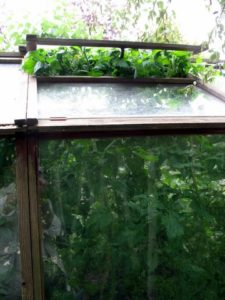
Each stage has a common problem to avoid
.
Too many leaves
If you’ve grown tomatoes in the past and found that you’ve been overwhelmed by lots of green healthy leaves and hardly any tomatoes, it is because the plants have received too much nitrogen just before the flowering stage.
This is often the result of transplanting into the final position – and lots of new compost containing a lot of nitrogen – just before the plants have begun to flower.
Too much nitrogen will keep a plant in the leaf growing stage longer than is desired.
Pro Tip: It’s best to transplant into the final position after the plants have begun to flower. However, if your plants are still only around 6 to 10 inches tall, after your last frost, planting in final position before flowering will be fine as there is still a lot of growing to do before the flowering stage.
Reacting To The Season – Low Light Levels
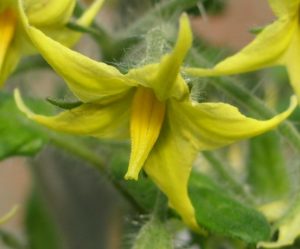
Plenty of sunshine in the spring will encourage early flowering and a lot of flowers.
However, sometimes, owing to long periods of dull weather in the spring, the development of buds and flowers is delayed.
At such times I plant many of my tall varieties into their containers before they come into flower – they are just too big to keep in 5inch pots any longer!
This will delay flowering by a week or so and make the plants more leafy, but I would rather have healthy plants that mature slightly later, than pot-bound weaklings. I will probably need to remove some of the lower leaves though!
2. The flowering stage
It’s exciting to see flowers open because each one is a potential tomato! However, it is important to be aware of Blossom Drop – this happens when flowers fail to pollinate and the flower buds drop off the end of their stems.
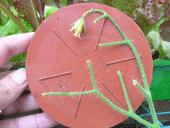
Whole trusses and clusters of flowers can fail which is very disappointing. This is because flowers fail to set (fertilise) owing to very dry or very damp weather.
Stress can also cause plants to abort their flowers if they feel they cannot cope because of poor growing conditions or being over-watered or over-fed etc.
Pro Tip: Tap and mist plants to help pollinate flowers.
When growing conditions are poor
Applying a foliar feed with a tonic such as liquid seaweed, SP Plant Invigorator or Vitalink Foliar can help strengthen a plant’s immune system and keep it happy when conditions are unfavourable.
The first sign of a problem is usually shown as stress in the leaves, such as leaf curl, leaf roll. Keeping an eye on your plants and their leaves is an essential part of growing tomatoes and catching problems early.
3. The fruiting stage
This is when flowers begin to set, that is, start to show tiny pea-like tomatoes as the blossoms fade and die away.
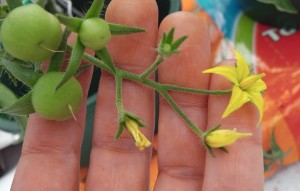
It is at this stage that they need plenty of food – phosphorus and especially potash (potassium) to be exact. It is also at this stage that if they don’t receive enough calcium, Blossom End Rot is waiting to strike!
Because calcium is an immobile nutrient, and doesn’t travel around a plant’s system freely, it is often easier to spray the leaves with calcium, which helps get it to where it is needed more quickly, than to hope for the best through the roots!
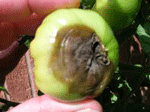
Pro Tip: Foliar spray with Chempak Calcium as the tomatoes are swelling. Milk is sometimes used as a foliar spray – use low fat milk mixed with water 50-50 and spray the underside of leaves nearest the forming truss of tomatoes. No need to spray the whole plant as the fruit will take nutrients from the nearest leaf branch. In general, try to keep leaves dry.
To Sum Up
In each of the three stages of growth in tomato plants, there is a major problem to avoid:
- Leaf stage – too much nitrogen will encourage too many leaves and flowering will be delayed.
- Flowering stage – Blossom Drop, when flowers fail to set, is a major problem when humidity or stress effects pollination.
- Fruiting stage – Blossom End Rot happens when leathery patches appear on the underside (blossom end) of the tomatoes because of a lack of calcium as the tomatoes swell.
Prevention is relatively easy, but curing a problem after it has taken hold is much harder and often impossible!
Hence the tomato grower’s motto: “prevention is better than cure”.
Here are a few tomato growing items that will get you off to a great start this season. Click Here.
N.B. The life cycle of a tomato plant is usually divided into “Vegetative and Generative” stages, similar to “Grow and Blume”.
When feeding tomatoes, hydroponic growers usually divide their feeding regime into three –
- From seedling to around 15 inches
- 15 inches to first fruit set
- First fruit to maturity
More about feeding tomatoes can be found here.
See also: Blight free tomato seed.


Anne
At the end of fruit production do we just dispose of the whole plant or would it continue to grow for next year and bear fruit again?
Nick
It is best to dispose of the plant and start fresh for the best crop yield.
If you live in an “all year round” climate like Florida, it is possible to grow for a second or third season from the same plant. However, first season plants are usually more vigorous.
Alan McGibbon
My plants are in 3.5 inch pots and are about 10 inches high. The proper leaves on some of them have a touch of yellow. In the past I’ve just left them until the first hint of a flower appeared and then planted them in their final position in the greenhouse by which time they look drawn and stressed. I feel that it’s too cold to move them out from the conservatory here in Scotland so should I pot them on into slightly larger pots? My worry is that they get too much fertiliser from the new potting compost and so expend their energy on producing more leaves.
Nick
Plant them in larger pots – 5 or 6 inch pots will be fine.
James Murray
Pot on your plants to a larger pot when you see the roots coming through the bottom of the pot it is in but don’t pot in a pot too big
Didi
Hi Nick,
I am new to planting. I started my tomatoes mid February and they are 3 weeks old. When would you advise is the right time to transplant them and how do I avoid transplant shock.
Thank you
Didi
Nick
I usually transplant every 4 weeks or so. Give them a day in the shade after transplanting to avoid shock.
Laura Gray
HI – I have a tomato plant which has grown about 3 feet tall and is now beginning to flower. I do not know where I got the plant or what to do with it. It is October in UK and the plant is in the kitchen window. What can I do to encourage it to fruit? Is it not the wrong time of year completely? Thanks Nick
Nick
Hi Laura, It is the wrong time of year unless you use grow lights.
Best sow in March when there is more light.
Yahaya Mahama
Hi, I planted my tomatoes for the first two weeks I realised the stem becomes thin and plant begin to wilt and die off.pls what is the possible cause
Thank you
Yahaya
Nick
Impossible to say with a picture of the plant but it could be a root disease if the leaves look ok.
Marc Justin
Hi Nick! If I am going to use the Trichogramma Chilonis Parasitism on the tomato plant, in what stage does the parasitsm is effective to apply?
Nick
Hi Marc, I have never used biological control of insect pests using egg parasitoids but I’ve seen them displayed at growing expo’s and conventions and they are becoming more and more popular for greenhouse use.
I suggest that you check with the manufacturer’s instructions when you buy the cards.
Jenny
Hi Nick,
My tomato plant has grown at 1.2m tall and lots of leaves since 5 months ago! Therefore there’s some curling leaves but no development of flowers as well as fruits and the stem is tiny! The tomato plant is fed with organic fertilizer and adequate nitrogen once a week. I realise the leaves are smell bitter!
Kindly advise me to deal with this problems!
Thank you.
Regards,
Jenny
Nick
Hi Jenny,
From your email address, I’m assuming you are in Singapore.
The plant may need more light to stimulate flowering/fruiting.
If it’s in a small pot, less than 9 inches, it may need a bigger container and this could be the cause of stunted growth.
If it’s growing in the back garden soil, you may have a soil problem which could also be the cause of stunted growth.
I suggest you give it a foliar feed and see if that helps.
Regards,
Nick
Remo Flavia
Hi Nick, thank you for the information you provide, i would like to know if its possible for a tomato plant to survive and bear fruits it it was infected by the bacterial wilt disease and what are the symptoms of the fruits during the harvesting period?
thanks,
Flavia.
Richard Jones
Hi Nick,
I have tomato plants growing strongly in the greenhouse with plenty of trusses forming, however, some of the trusses have started growing leaves from the ends i.e. beyond the flowers. Not sure whether I should remove them or not – any thoughts?
Cheers. Richard
Nick
Hi Richard,
I always remove these leafy extensions as they will slow the growth of the flowers/fruit when they set.
Cheers,
Nick
Richard Jones
Thanks Nick. Any idea why it happens?
Bob
Hi Nick
this is our first year growing tomatoes we have 2 money maker plants indoors south facing so far about 5ft high showing good signs of fruit and a few tomatoes already nicely formed, we have had a huge array of green leaves which we have cut back as a lot of the truss’s did not show any signs of flowers did we do right ?? this is the bit im not sure off can you advise we felt that all the growing and nutrition was being wasted on the long leavy truss’s
thanks Bob
Nick
Hi Bob,
You may be confusing trusses with leaf branches.
Trusses will only grow buds, flowers and fruit (usually), and leaf branches will only grow leaves.
You can remove the leaf branches at the bottom of a tall variety up to the first truss. After the first truss has got lots of tomatoes on it, you can also remove leaf branches that are up to the second truss.
Too many leaves can, as you say, use up energy that could be going into fruit production.
Hope that helps …
Regards,
Nick
Jim
Hi Nick.
This is my first attempt at growing anything and my tomato plants which are Cherry & Tigerella, displaying nearly 30 flowers, are approximately 4ft in height at present in my front window, and at the rear 2ft in height, these are of the money maker varieties.
How long will they go before their start to produce fruit.
jim.
Nick
Hi Jim,
When the flowers begin to die away they are replaced by tiny pea-size fruit. This could be any time after the flower begin to fade, but from flowers to mature fruit usually takes around ten to twelve weeks for a medium variety like Moneymaker.
Regards,
Nick
David
Hi Nick,
I have Moneymakers and Roma Plums starting to flower but with the lack of sunshine (light and heat) they are only 8″ tall with a stem of about 3/8″, last year they were twice the size before flowering. Will they be OK or should they be taken off like suckers?
Regards, David.
Nick
Hi David,
I would leave them as they are…as the weather improves they should begin to thicken-up.
It’s been a difficult season for light levels so far, the trick is to keep the soil as dry as possible (without the plants wilting) to prevent leggy growth.
Regards,
Nick
nass
i have a serious problem treating bacterial wilt. bacteria seam to be in water because i have treated the soil. how can I treat water with chlorine or any other agent without affecting the growth of the tomato. Last time I did this with Chloride of calciam the crop stopped growing…..?
What is the best chemical suited for treating water for tomato- against bacterial wilt?
Nick
I’m sorry Nass, but I have no experience of treating bacterial water problems.
I think the best suggestion is to contact your nearest university horticulture department and ask their advice as this is a problem that is probably common in your part of the world.
Best wishes,
Nick
Bob Iles
Hi Nick, all my different varieties are in five inch pots and looking really good except Gardeners Delight which have the bottom leaves starting to turn yellow, any ideas would be very welcome. Regards Bob.
Nick
Hi Bob,
Yellow leaves at the bottom is quite normal – the nutrients are sent to the growing tip and the bottom leaves have to go hungry!
Just snap off the yellow leaf branches and that will help keep the plant healthy.
Regards,
Nick